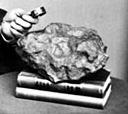Still working to recover. Please don't edit quite yet.
meteorite
A meteorite is a small extraterrestrial body that impacts the Earth's surface. While in space they are called meteoroids, and while falling through Earth's atmosphere they are called meteors. These are small asteroids, approximately boulder-sized or less. When it enters the atmosphere, air drag and friction cause the body to heat up and emit light, thus forming a fireball or shooting star.
More generally, a meteorite on a celestial body is a small body that has come from elsewhere in space.
Overview[edit]
Most meteors disintegrate when entering the Earth's atmosphere, making impact events (Earth impacts) on the surface uncommon. About 500 baseball-sized rocks reach the surface each year. Large meteorites may strike the ground with considerable force, leaving behind an impact crater. The kind of crater will depend on the size, composition, degree of fragmentation, and incoming angle of the meteor. The force of collision may cause widespread destruction. Occasional damage to property, livestock, and even people has been recorded in historic times. In the case of comet fragments, which are largely composed of ice, a considerable concussion may occur, even though no fragment of the original meteoroid survives; the famed Tunguska event is thought to have resulted from such an incident.
79% of meteorites are chondrites - balls of mafic minerals with small grain size indicative of rapid cooling. In most chondrites small spherules, called chondrules, can be found. Chondrites are typically about 4.6 billion years old and are thought to represent material from the asteroid belt. It is unknown how they formed. Carbonaceous chondrites, thought to be unaltered solar nebula material, constitute about 5% of meteorites and contain small amounts of organic materials, including amino acids. Also, presolar grains are identified in carbonaceous chondrites. The isotope ratios of carbonaceous chondrites are similar to those of the Sun.
Achondrites are similar to terrestrial mafic igneous rocks and sometimes are brecciated. Achondrites constitute about 8% of the incoming material and are thought to represent crustal material of some of the larger asteroids (mostly 4 Vesta) and occasionally Mars. About 6% of meteorites are iron meteorites with intergrowths of iron-nickel alloys, such as kamacite. Unlike chondrites, the crystals are large and appear to represent slow crystallization. Iron meteorites are thought to be the core material of one or more planets that subsequently broke up. Stony iron meteorites constitute the remaining 2%. They are a mixture of iron-nickel and silicate minerals. They are thought to have originated in the boundary zone above the core regions where iron meteorites originated. A small number of meteorites belong to additional groups or subgroups with unique chemical characteristics relative to other members of the larger groups, such as lunar meteorites or Martian meteorites. Tektites (from Greek tektos, molten), natural glass objects up to a few centimeters in size, were formed--according to most scientists--by the impact of large meteorites on Earth's surface, although a few researchers favor an origin from the Moon as volcanic ejecta.
A classification of meteorite types can be found here.
One theory stipulates that a large meteorite impact caused the mass extinction of the dinosaurs. It is also theorized that meteorites caused other mass extinction events as well throughout the history of the earth.
The only reported fatality from meteorite impacts is an Egyptian dog who was killed in 1911, although this report is disputed. The meteorites that struck this area were identified in the 1980s as Martian in origin.
The first known modern case of a human hit by a space rock [1] occurred on November 30 1954 in Sylacauga, Alabama. There a 4 kg stone chondrite meteorite [2] crashed through a roof and hit Ann Hodges in her living room after it bounced off her radio. She was badly bruised. Several persons have since claimed [3] to have been struck by 'meteorites' but no verifiable meteorites have resulted.
Indigenous peoples often prized iron-nickel meteorites as an easy, if limited, source of iron metal. For example, the Inuit used chips of the Cape York meteorite to form cutting edges for tools.
Notable meteorites[edit]
- Heat Shield Rock
- Sayh al Uhaymir
- Willamette Meteorite (the largest meteorite ever found in the United States)
- Orgueil meteorite
- Canyon Diablo meteorite
- Sikhote-Alin Meteorite
- Cape York meteorite
- ALH84001
See also[edit]
External links[edit]
| This article contains content from Wikipedia. Current versions of the GNU FDL article meteorite on WP may contain information useful to the improvement of this article | WP |
- www.aerolite.org: Meteorite photographs, articles on meteorite hunting
- MeteoriteTimes.com: Free On-line Meteorite Magazine
- Meteorites.com.au - No. 1 Meteorite Information Website
- Meteorite.fr - All about Meteorites
- Natural History Museum of Vienna
- Heavenly Bodies - Meteorite information (E / NL)
- Meteoritical Society
- The Natural History Museum's Meteorite Catalogue Database
- Meteorite hits
- Largest meteorites
- Article with image of Hoba, world's largest meteorite


